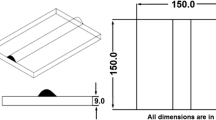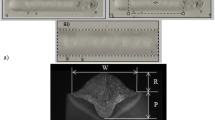Abstract
Pulsed gas metal arc welding is one of the most widely used processes in the industry. It offers spray metal transfer at low average currents, high metal deposition rate, versatility, less distortion, and the ability to be used in automated robotic welding systems. The weld bead plays an important role in determining the mechanical properties of the weld. Its geometric parameters, viz., width, reinforcement height, and penetration, are decided according to the welding process parameters, such as wire feed rate, welding speed, pulse current magnitude, frequency (cycle time), etc. Therefore, to produce good weld bead geometry, it is important to set the proper welding process parameters. In the present paper, mathematical models that correlate welding process parameters to weld bead geometry are developed with experimental investigation. Taguchi methods are applied to plan the experiments. Five process parameters, viz., wire feed rate, plate thickness, pulse frequency, pulse current magnitude, and travel speed, are selected to develop the models using multiple regression analysis. The models developed were checked for their adequacy. Results of confirmation experiments show that the models can predict the bead geometry with reasonable accuracy.
Similar content being viewed by others
References
McGlone JC (1982) Weld bead geometry prediction—a review. Met Constr 14:378–384
Pandey S, Parmer RS (1989) Mathematical models for predicting bead geometry and shape relationships for MIG welding of aluminum alloy 5083. Proceedings of the 2nd International Conference on Trends in Welding Technology USA, 14–18 May, pp 37–41
Senthil Kumar R.and Parmar RS (1986) Weld bead geometry prediction for pulse MIG welding. Proceedings of an International Conference on Trends in Welding Technology, USA, 18–22 May, pp 647–652
Subramaniam S, White DR, Lones JE, Lyons DW (1999) Experimental approach to selection of pulsing parameters in pulsed GMAW. Weld J 78(5):166–172
Kim IS, Kwon WH, Siores E (1996) An investigation of a mathematical model for predicting weld bead geometry. Can Metall Q 35(4):385–392. doi:10.1016/S0008-4433(96)00012-2
Kim IS, Park CE, Jeong YJ, Son JS (2001) Development of an intelligent system for selection of the process variables in gas metal arc welding processes. Int J Adv Manuf Technol 18:98–102. doi:10.1007/s001700170080
Kim IS, Son JS, Kim IG, Kim JY, Kim OS (2003) A study on relationship between process variables and bead penetration for robotic CO2 arc welding. J Mater Process Technol 136:139–145. doi:10.1016/S0924-0136(02)01126-3
Kim IS, Son KJ, Yang YS, Yarlagada PKDV (2003) Sensitive analysis for process parameters in GMA welding processes using a factorial design method. Int J Mach Tools Manuf 43:763–769. doi:10.1016/S0890-6955(03)00054-3
Ramaswamy S, Gould J, Workman D (2002) Design-of-experiments study to examine the effect of polarity on stud welding. Weld J 81(2):19–26s
Allen TT, Richardson RW, Tagliabue DP, Maul GP (2002) Statistical process design for robotic GMA welding of sheet metal. Weld J 81(5):69–77s
Montogomory DC (2001) Design and analysis of experiments, 5th edn. Wiley, New York
Weber DC, Skillings JH (2000) A first course in the deign of experiments. CRC, Boca Raton
Phadke MS (1989) Quality engineering using robust design. Prentice Hall, Englewood Cliffs, New Jersey
Ross PJ (1996) Taguchi techniques for quality engineering, 2nd edn. McGraw-Hill, New York
Bendell T (ed) (1988) Taguchi methods. Proceedings of the 1988 European Conference, Elsevier Applied Science, London
Jaung SC, Tarng YS (2002) Process parameter selection for optimizing the weld pool geometry in the tungsten inert gas welding of stainless steel. J Mater Process Technol 122:33–37. doi:10.1016/S0924-0136(02)00021-3
Tarng YS, Yang WH, Juang SC (2000) The use of fuzzy logic in the Taguchi method for the optimization of the submerged arc welding process. Int J Adv Manuf Technol 16:688–694. doi:10.1007/s001700070040
Xue Y, Kim IS, Park CE (2004) Application of Taguchi’s method on the optimized bead geometry in the gas metal arc welding. Proceedings of the 3rd International Conference on Advanced Manufacturing Technology (ICAMT 2004), Kuala Lumpur, 11–13 May, pp 771– 776
DATAFIT 8.0.32 (2004) User manual. Oakdale Engineering, USA
Author information
Authors and Affiliations
Corresponding author
Rights and permissions
About this article
Cite this article
Rao, P.S., Gupta, O.P., Murty, S.S.N. et al. Effect of process parameters and mathematical model for the prediction of bead geometry in pulsed GMA welding. Int J Adv Manuf Technol 45, 496–505 (2009). https://doi.org/10.1007/s00170-009-1991-1
Received:
Accepted:
Published:
Issue Date:
DOI: https://doi.org/10.1007/s00170-009-1991-1




